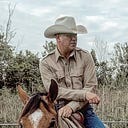Member-only story
Cowboy Gear: Why Spurs Are For More Than Just Looks
To most any person raised in the city, the cowboy’s jingling spur rowels might appear to be pure pretension, but the spurs to which they are attached are a very necessary part of his equipment. Not that the cowboy doesn’t enjoy the jingle mind you. In fact, long ago cowboys are known to have fastened small pear-shaped pendants to the axle of the spur rowel and called them “jingle-bobs.” The sole purpose of the jingle-bob is to jingle-jangle when our cowboy walks — typically bow-legged from so many hours in the saddle and typically slowly from, well, so many hours in the saddle.
But purpose is far more important than style to the cowboy. Large-roweled spurs are usually preferred. The larger the rowel the more points it has and many points don’t dig as deeply into a horse’s flank as the few points on a small rowel. Spurs are kept in place on the boot by a broad, crescent-shaped piece of leather laid over the instep referred to, not surprisingly, as a spur strap. Occasionally chains also pass under the boot in front of the heel to anchor the spurs, but if a cowboy’s spurs are well-balanced and custom built, chains are simply not necessary.
Spurs in the Old West
In the old west, a cowboy never buckled on a pair of spurs until he had filed the sharp rowels to make them blunt. Sharp rowels make a…
